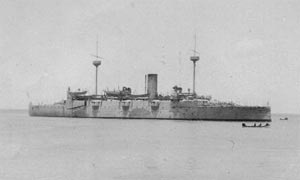USS Charleston (C-2)

USS Charleston in Manila Bay, 1898
|
|
| History | |
|---|---|
|
|
|
| Name: | Charleston |
| Namesake: | |
| Builder: | Union Iron Works, San Francisco |
| Laid down: | 20 January 1887 |
| Launched: | 19 July 1888 |
| Sponsored by: | Mrs. A. S. Smith |
| Commissioned: | 26 December 1889 |
| Decommissioned: | 27 July 1896 |
| Recommissioned: | 5 May 1898 |
| Identification: | Hull symbol:C-2 |
| Fate: | grounded 2 November 1899 near Camiguin Island, Philippines and abandoned |
| General characteristics | |
| Type: | Protected cruiser |
| Displacement: | 3,730 long tons (3,790 t) |
| Length: | 320 ft (97.5 m) |
| Beam: | 46 ft (14.0 m) |
| Draft: | 18 ft 6 in (5.64 m) |
| Installed power: |
|
| Propulsion: | 2 × screws |
| Speed: | 19 knots (35 km/h; 22 mph) designed |
| Range: | 2,990 nmi (5,540 km; 3,440 mi) at 10 kn (19 km/h; 12 mph) |
| Complement: | 34 officers, 296 men, 30 Marines |
| Armament: |
|
| Armor: |
|
| Service record | |
| Commanders: |
|
| Operations: | |
The second USS Charleston (C-2) was a United States Navy protected cruiser — the fourth US protected cruiser to be built. Lacking experience in building steel cruisers, the design was purchased from the British company Armstrong, Mitchell and Co. of Newcastle, the construction to be by an American shipyard. In design, she succeeded the "ABC" cruisers Atlanta, Boston, and Chicago with better protection, higher speed, and similar armament.
She was launched on 19 July 1888 by Union Iron Works, San Francisco, California, sponsored by Mrs. A. S. Smith, and commissioned on 26 December 1889, Captain George C. Remey in command.
Charleston was built with plans purchased from Armstrong, a British manufacturer, which were similar to the Armstrong-built Japanese cruiser Naniwa and launched in 1885. USS Baltimore was also built to Armstrong plans. Building Charleston's propulsion machinery proved troublesome; apparently it was a combination of components of several different plants. Union Iron Works had to make costly changes in order to build the ship.
Charleston was armed with two 8-inch (203 mm)/35 caliber Mark 3 guns, one each in bow and stern barbettes, and six 6-inch (152 mm)/30 caliber Mark 3 guns in sponsons along the sides. The 8-inch guns were initially unavailable, so from her commissioning in 1889 until a refit in 1891 they were replaced by four additional 6-inch guns. Secondary armament was four 6-pounder (2.2 in (57 mm)) guns, two 3-pounder (1.85 in (47 mm)) Hotchkiss revolving cannon, two 1-pounder (1.5 in (37 mm)) Hotchkiss revolving cannon, and two .45 caliber (11.4 mm) Gatling guns. Four 14-inch (356 mm) torpedo tubes were included in the design but never mounted.
...
Wikipedia
